
Eagle

Order: Falconiformes Family: Accipitridae Genus & Species: Haliaeetus leucocephalus
The bald eagle is the national bird of the USA and is a symbol of power, freedom and majesty.
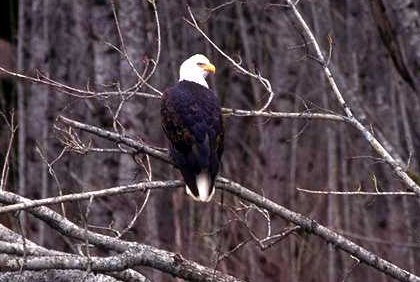 |
Habitat The bald eagle is found in a remarkable range of habitats, from Arctic coast bordered by extensive coniferous forests, to inland freshwater lakes and rivers. In southern parts of USA, such as Florida, it is quite at home in cypress swamps and mangroves, while it even inhabits parts of the dry, hot deserts of the Baja peninsula in northern Mexico. |
| When not flying, the bald eagle may be seen perched at the top af a tall tree near the waters edge, on the lookout for fish or any other prey to come into view. Inland nesting eagles migrate southwards in winter and some of these migrant birds spend the non breeding season in arid open country, far from water. |
Behaviour
As with most birds of prey, the female is larger than the male. This is
known as reversed sexual dimorphism. It is important that the female is large and
strong, making her more able to defend herself against aggressive males, especially when
she has young to look after. The size difference also reduces competition for food
to an extent, as the female can target prey which is too large for the male to cope with.
Sometime the bald eagle will turn to piracy. They frequently intimidate and harass
ospreys which are exclusively fish eating birds of prey, found in a similar range of
habitats. Being smaller, ospreys are forced to surrender their catches.
 |
What they eat Although specialised for catching fish, the bald eagle takes a range of prey, including seabirds, waterfowl, mammals and reptiles. In Alaska during the autumn, when the salmon make their up stream runs to spawn and die, bald eagles often gather in large numbers to feed on the dying fish. Some birds have been seen wading through the fast flowing waters to snatch the weakened salmon. In winter, when many birds move south from their breeding grounds, carrion and even scraps become an important part of the bald eagles diet. |
Breeding The bald eagle may build a nest on the ground, in a tree or on a cliff, depending on its locality. They usually re-use the same nest year after year. Usually two eggs are laid several days apart. The first chick hatched will have the advantage of size and weight over the second one and if food is scarce, will bully the younger one until it dies of starvation. This ensures that in years when food supplies are short, at least one chick can be raised successfully |
 |
Golden Eagle
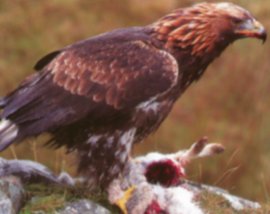
Order: Falconiformes Family: Accipitridae Genus & Species: Aquila chrysaetos
The golden eagle, popularly called the 'king of the birds', is an inhabitant of the west and north USA and eastern Canada, the mountainous parts of Europe, much of central and northern Asia and parts of Africa.
| Habitat The golden eagle favours open, often mounainous habitats across its range. It avoids densely wooded areas and heavily populated and intensively farmed areas. The golden eagle is also absent from flat landscapes, such as prairies or steppe grasslands, as they offer few high vantage points from which it can perch and watch for prey. |
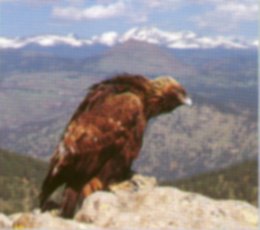 |
Behaviour
Male and female golden eagles usually mate for life, establishing a home
territory and staying there year after year. However, eagles in the far north are
migratory, flying to warfmer lowlands to avoid the extremes of winter. In the late
winter, p[airs of birds are often seen soaring and swooping together in a form of display
called sky dancing. This is a mating ritual in which the female may roll on her back
and present her talons to the male as he swoops past. Mating takes place on the
ground and is often followed by further soaring flights and sky dancing.
What they eat
Typical prey of the golden eagle are small to medium sized mammals such as
rabbits, hares ground squirrels, marmots and young deer and birds such as grouse,
partridges and pheasants. Prey is usually spotted by the eagle as it flies low over
the ground. In a high speed glide, it drops and grabs its prey in its talons.
Gamebirds may be snatched in mid air. Pairs of eagles sometimes hunt together, one
flushing out the prey, the other swooping in to kill it. Small prey is crushed by
the eagles powerful talons and the sharp claw on each hind toe pierces the victims body to
kill it swiftly. The eagle then tears its catch apart on the spot. In winter
they will feed on carrion.
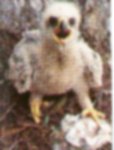 |
Breeding Within a territory, a pair of golden eagles may have up to a dozen nest sites, called eyries. Each spring, the pair select one eyrie and renovates it with fresh twigs. Egglaying takes place from January in the south of the species range and from May in the most northerly regions. The female incubates her first egg immediately and lays a second egg two to five days later. The male undertakes only occasional shifts on the nest. When the first chick is hatched after six weeks, the male begins bringing food to the nest which the female tears into morsels for the chick. By the time the second chick hatches, the first chick is growing rapidly. In years when food is scarce, the second chick may be attacked and killed by the older chick. This ensures that at least one chick receives enough food to survive. |
Martial Eagle
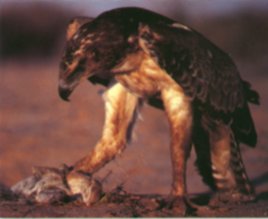
Order: Falconiformes Family: Accipitridae Genus & Species: Polemaetus bellicosus
The martial eagle is a member of the family Accipitridae, which also includes hawks, Old World vultures, harriers and kites. It is closely related to the bald eagle and Bonelli's eagle, of Europe, Africa and Asia.
| Habitat The martial eagles habitat is one of rolling savannah with occasional trees dotting the landscape. It often flies over open woodland and along rivers, hoping to catch sight of prey unprotected by cover. This wide ranging eagle uses one of several favoured trees for overnight roosting as well as for regular nest sites. It also requires an unfailing supply of water as it likes to bathe often to keep its flight feathers clean and working efficiently. |
 |
Behaviour
The martial eagle hunts by sight so, like all birds of prey, it waits until
the sun rises before leaving its tree roost to patrol the skies. Another good reason
to wait for sunrise is so that it can take advantage of the sun's warmth. The
morning sun heats up the ground, causing thermals (columns of warm air) to rise. The
broad winged martial eagle is well adapted for soaring on these thermals like a glider.
While riding a thermal, it scans the ground for prey, if none can be found, it
slips out of that thermal and glides or flies across country until it finds another one.
The eagle may travel vast distances like this every day, covering a home range of
200 sq km or more with little effort.
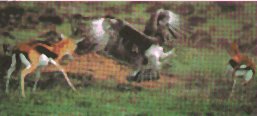 |
What they eat The martial eagle attacks and eats virtually any mammal, reptile or bird it can overpower. When it selects its quarry, it folds its wings slightly and tumbles into a dive, accelerating as it rushes downwards. At the last moment, it brakes hard with wings spread and talons thrust forward, but it still strikes with enough force to knock down and even kill its prey. The sheer force can be enough to knock down prey as large as young gazelle. The eagle usually eats at the site of the kill. It may feed from a big carcass for up to five days, roosting in a nearby tree between meals. |
Breeding A female martial eagle rarely lays more than one egg each season. For the first two months , the smaller male does most of the hunting while the female stays on guard at the nest. On his return, the male often passes the food to the female rather than offering it directly to the chick. This enables her to claim a share of the spoils. After six months or so the young eagle is ready to take to the air. Once it has made its first flight, it spends more and more of its time aloft, flying alongside its parents and sharing their prey while learning how to hunt for itself. After it has made a few successful kills, it leaves to find a territory of its own. |
 |